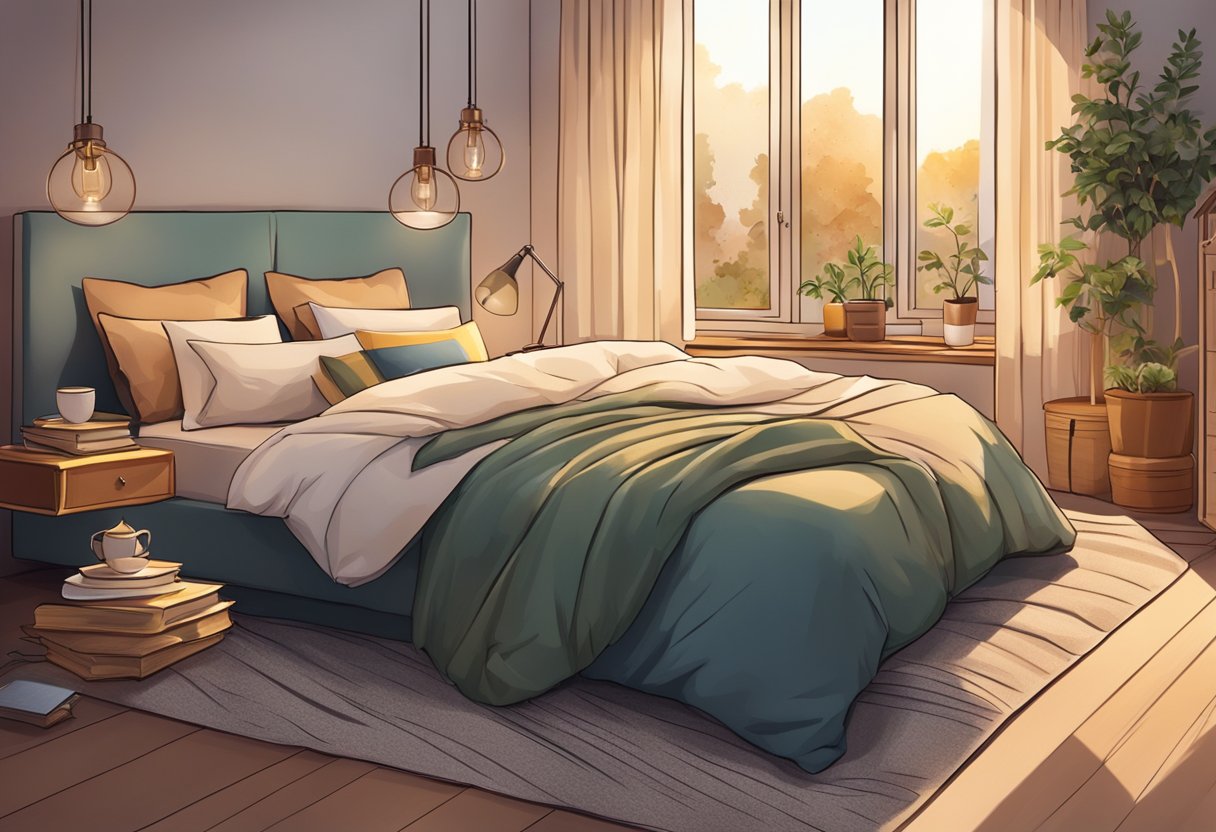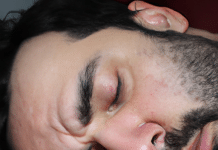Are you struggling to get a good night’s sleep because your bedroom is too cold? You’re not alone.
Many people find it difficult to sleep when their bedroom is chilly, but there are steps you can take to sleep well tonight. In this article, we’ll share three steps to ensure your bedroom is warm and comfortable to get the restful sleep you need.
While most people will be comfortable sleeping in a cool room or one that borders on cold, the reality is that it is just as unhealthy to sleep in a cold room as it is to sleep in a space that is too hot.
Of course, you can always put on some warm pajamas, crawl under a pile of blankets or a feather bed, and be friendly.
Review contents
3 Action Steps to Sleep Well Tonight
First, we’ll examine why a cold bedroom can make sleeping difficult. When we’re cold, our bodies naturally try to warm up, making it hard to relax and fall asleep. In addition, a chilly room can cause our muscles to tense up, making it harder to get comfortable. By understanding why a cold bedroom can be a problem, we can take steps to address the issue and get a good night’s sleep.
Next, we’ll explore three action steps you can take to make sure your bedroom is warm and cozy. These steps are simple and easy to implement and can make a big difference in your sleep quality. Whether you’re dealing with a drafty old house or prefer a warmer sleeping environment, these tips will help you create the perfect sleep environment. So, let’s get started and learn how to sleep well tonight, even if your bedroom is too cold.
Understanding Bedroom Temperature and Sleep Quality
Getting a good night’s sleep is essential for our health and well-being. One of the factors that can affect sleep quality is bedroom temperature. This section will explore the relationship between bedroom temperature and sleep quality.The Science of Sleep Cycles and Bedroom Temperature
Our body temperature naturally drops as we fall asleep and reaches its lowest point during the deep sleep stage of the sleep cycle. The ideal temperature for sleep is between 60-68°F (15.5-20°C) Sleep Foundation. A more relaxed room makes it easier to fall and stay asleep. On the other hand, a room that is too warm can interfere with the natural drop in body temperature, making it harder to fall asleep and stay asleep.
How Cold Symptoms Affect Sleep
If you have a cold and your bedroom is too cold, it can make it harder to sleep. Congestion and mucus buildup can make breathing difficult, and the cold temperature can worsen these symptoms. In this case, it might be helpful to raise the temperature slightly to make breathing easier. However, it’s important not to make the room too warm, as this can interfere with the natural drop in body temperature during sleep.
To summarize, the ideal temperature for sleep is between 60-68°F (15.5-20°C). A more relaxed room makes it easier to fall and stay asleep. If you have a cold, finding the right balance between a comfortable temperature and making breathing easier is essential. In the next section, we will explore some action steps you can take to improve your sleep quality in a cold bedroom.
Optimizing Your Sleep Environment
When getting a good night’s sleep, your bedroom environment plays a crucial role. Here are three steps to optimize your sleep environment and ensure you sleep well tonight.Choosing the Right Bedding
The right bedding can make all the difference in how warm and comfortable you feel at night. When choosing bedding, consider your blankets and sheets’ material, weight, and thickness. For example, a down comforter or electric blanket can provide extra warmth on cold nights, while a lightweight cotton sheet is perfect for warmer weather. Additionally, consider investing in a heated mattress pad to keep your bed warm and cozy throughout the night.
Adjusting the Room Temperature
The temperature of your bedroom can also significantly impact your sleep quality. According to the Sleep Foundation, the ideal temperature for sleep is between 60 and 67 degrees Fahrenheit. Adjust the thermostat to a slightly higher temperature if your room is too cold. Alternatively, consider using a fan or opening a window to let in some fresh air if your room is too warm.
Sealing Out Drafts
Drafts can make your bedroom feel colder than it is, so it’s essential to seal them out. Check for drafts around windows, doors, and other openings, and use weather stripping or draft stoppers to seal them up. Additionally, consider investing in insulated curtains or blinds to help keep the cold and warm air out.
Following these three action steps can optimize our sleep environment and ensure we sleep well tonight. Remember to choose the right bedding, adjust the room temperature, and seal out drafts to create a warm, cozy bedroom promoting restful sleep.
Pre-Bedtime Routines for Warmer Nights
When the bedroom is too cold, falling asleep and staying asleep throughout the night can be difficult. However, several pre-bedtime routines can help us sleep better in a colder room. This section will discuss the benefits of a warm beverage before bed and creating a relaxing pre-sleep ritual.
The Benefits of a Warm Beverage Before Bed
Drinking a warm beverage before bed can help raise our body temperature and make us feel cozy. This can be especially helpful in a cold bedroom. Some tremendous warm beverages to drink before bed include herbal tea, warm milk, and hot cocoa. These beverages can also help us relax and unwind before going to sleep.
Creating a Relaxing Pre-Sleep Ritual
Creating a relaxing pre-sleep ritual can help us wind down and prepare for a good night’s sleep. Some things that we can do to create a relaxing pre-sleep ritual include:
- Taking a hot shower or bath: A hot shower or bath can help us relax and raise our body temperature, making us feel warmer when we get into bed.
- Putting on warm pajamas: Wearing warm pajamas can help us stay warm throughout the night.
- Taking melatonin: Melatonin is a hormone that helps regulate our sleep-wake cycle. A melatonin supplement before bed can help us fall asleep faster and stay asleep throughout the night.
By incorporating these pre-bedtime routines, we can create a warm, relaxing environment that promotes a good night’s sleep, even in a cold bedroom.
Lifestyle Adjustments for Improved Sleep
Regarding sleeping well, lifestyle adjustments can play a significant role. In this section, we will discuss two crucial lifestyle factors that can impact your sleep: diet and pets.
Dietary Considerations for Better Sleep
What we eat and drink can significantly impact our sleep quality. Here are some dietary considerations that can help improve your sleep:
- Caffeine: Caffeine is a stimulant that can keep you awake and alert. It is found in coffee, tea, chocolate, and soft drinks. We recommend avoiding caffeine at least six hours before bedtime.
- Alcohol: While alcohol can help you fall asleep faster, it can also disrupt your sleep later in the night. We recommend limiting alcohol consumption and avoiding it at least two hours before bedtime.
- Sugar: Consuming sugary foods and drinks close to bedtime can cause a spike in blood sugar levels, leading to restlessness and difficulty falling asleep. We recommend avoiding sugary foods and drinks before bedtime.
The Role of Pets in Sleep Warmth
Pets can be great companions but can also impact your sleep quality, especially if your bedroom is too cold. Here are some things to consider when it comes to pets and sleep warmth:
- Pet Hair: Pet hair can collect dust and allergens, which can cause breathing problems and disrupt your sleep. We recommend keeping your pets well-groomed and washing their bedding regularly.
- Pet Warmth: Pets can provide warmth during cold nights, which can help improve your sleep. We recommend allowing your pets to sleep in your bedroom, not on the bed, to avoid disturbing your sleep.
By making these lifestyle adjustments, we can improve our sleep quality and wake up refreshed and energized.
Supplementary Tools and Techniques
Using Humidifiers and Fans Strategically
If your bedroom is too cold, you may want to consider using a humidifier or a fan. A humidifier can add moisture to the air, which can help regulate the temperature and make the room feel warmer. Additionally, humidifiers can help alleviate symptoms of dry skin, sinus congestion, and other respiratory issues. On the other hand, a fan can help circulate the air in the room and create a more comfortable sleeping environment.
When using a humidifier or a fan, it’s essential to use them strategically. For example, if the air in your room is already humid, using a humidifier may make the room feel overly warm and stuffy. Similarly, using a fan may make the room feel too cold if the air outside is cold. Experiment with different settings and positions to find the optimal balance.
When to Consider Additional Sleep Aids
Suppose you’ve tried adjusting the temperature, using a humidifier or a fan, and optimizing your bedding, but you’re still struggling to sleep well in a cold bedroom. In that case, it may be time to consider additional sleep aids. There are a variety of over-the-counter and prescription sleep aids available, including melatonin, valerian root, and prescription sleeping pills.
Before taking any sleep aids, you must talk to your doctor or a sleep specialist to determine the best action for your needs. Additionally, it’s essential to use sleep aids responsibly and according to the instructions on the label. Overusing sleep aids can lead to dependence, tolerance, and other adverse side effects.
In conclusion, you can use various tools and techniques to sleep well in a cold bedroom. By adjusting the temperature, optimizing your bedding, using a humidifier or a fan strategically, and considering additional sleep aids when necessary, you can create a comfortable and restful sleeping environment.
Frequently Asked Questions
What are effective strategies for warming up a bedroom before bedtime?
There are several effective strategies for warming up a bedroom before bedtime. One of the easiest ways is to use layered blankets and breathable fabrics, which can help maintain an optimal sleeping temperature and ensure a comfortable night’s rest. A space heater or an electric blanket can provide warmth and comfort during cold nights.
Can sleeping in a cold room negatively impact one’s health?
Sleeping in a cold room can negatively impact one’s health. According to the Cleveland Clinic, the ideal sleeping temperature for a bedroom is between 60 to 67°F (15 to 19°C). Sleeping in a room that is too cold can cause discomfort, interrupted sleep, and even health issues over time. It can also lead to respiratory problems, especially for people with asthma or allergies.
What techniques can help someone fall asleep quickly in a chilly environment?
Several techniques can help someone fall asleep quickly in a chilly environment. A warm bath or shower before bedtime can help relax the body and prepare it for sleep. Additionally, drinking a warm beverage, such as herbal tea or warm milk, can help promote relaxation and induce sleep. Relaxation techniques, such as deep breathing or meditation, can help calm the mind and body and promote better sleep.
What are some natural remedies to ensure a comfortable sleep during cold nights?
There are several natural remedies to ensure a comfortable sleep during cold nights. One of the most effective remedies is to use natural fabrics, such as wool or cotton, for bedding and clothing. These fabrics are breathable and can help regulate body temperature during sleep. Additionally, using essential oils, such as lavender or chamomile, can help promote relaxation and induce sleep.
How does the 10-3-2-1-0 sleep rule apply to achieving better sleep in a cold room?
The 10-3-2-1-0 sleep rule can be applied to achieve better sleep in a cold room. This rule suggests that you should avoid caffeine and alcohol for at least 10 hours before bedtime, stop eating 3 hours before bedtime, spend 2 hours before bedtime winding down and relaxing, spend 1 hour before bedtime doing a calming activity, such as reading, and have zero electronics in the bedroom. Following this rule can help promote better sleep and ensure a comfortable environment for sleep.
What measures can be taken to sleep well when anxious, especially in a cold bedroom?
When suffering from anxiety, especially in a cold bedroom, several measures can be taken to sleep well. One of the most effective measures is to practice relaxation techniques, such as deep breathing or meditation, before bedtime. Additionally, a weighted blanket can provide comfort and security during sleep. Creating a comfortable sleep environment, such as using comfortable bedding and pillows, can also help promote relaxation and better sleep.
The problem with this solution is that you may be too warm beneath the covers even though the room is too cold.
What’s the Solution?
- The first step to getting ready for sleep in a cool or cold room involves exercise. While many people may shut down at the first suggestion of this subject, you can prepare with a few stretching movements that involve raising your legs, stretching above your head with your arms, and taking some deep breaths between the different moves. This will slightly submit your body temperature and increase circulation to your extremities.
- Drinking a cup of tea or broth will help raise your body temperature. It will probably be best to limit your intake so you do not have to venture to the bathroom during the night. That defeats the purpose of preparing to sleep in a cold room. You may also get help with a warm bath or shower immediately before heading to the bedroom. Again, this raises the body temperature slightly and may help you stay warm long enough to sleep.
- Use layers rather than heavy clothing and blankets. Remember, the goal is to trap body heat. If you have a comfortable, relatively thin pair of pajamas, put them on first. Then, put another layer over that, gradually getting heavier clothes until you have three layers that are still comfortable enough to relax and fall asleep. It has been shown, in sleep studies, that most people sleep more deeply and are less restless when the space around them is excellent or even a bit cold. But you certainly do not want to make yourself too warm by trying to sleep in clothing you would wear outside on a cold day. In addition, you should not rely only on one heavy feather bed for cover because you have nowhere to go if that is too warm. Of course, this might be the solution if the room is freezing. Use layers with blankets, beginning with the usual bedsheet and gradually putting light or medium blankets on until you find your comfort zone.
Other Ideas
These are, by all means, not the only methods for sleeping comfortably in a cold room.
Warm your bedsheets and light blankets in the dryer before bed.
You could carefully use a hot water bottle or two, with one at your feet and one at your side. This has a similar effect as the old bed warmers of earlier days.






























